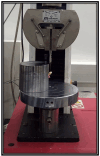The effect of varying thicknesses of mineral trioxide aggregate (MTA) and Biodentine as apical plugs on the fracture resistance of teeth with simulated open apices: a comparative in vitro study
- PMID: 39713144
- PMCID: PMC11662899
- DOI: 10.7717/peerj.18691
The effect of varying thicknesses of mineral trioxide aggregate (MTA) and Biodentine as apical plugs on the fracture resistance of teeth with simulated open apices: a comparative in vitro study
Abstract
Background: This study evaluates the fracture resistance of apical plugs created from Biodentine and mineral trioxide aggregate (MTA) in thicknesses of 3 and 5 mm within simulated open apex tooth models.
Methods: Fifty human maxillary central incisors were obtained from a pool of freshly extracted teeth. In order to replicate open apices without cavity preparation, ten teeth in the control group received apical-to-coronal preparation with Peeso reamers. The remaining 40 teeth were randomly assigned to four experimental groups and received either 3 or 5 mm Biodentine or MTA apical plugs.
Results: The mean fracture loads observed in this study were as follows: control group, 431.48 N (±34.55); 3 mm MTA, 774.88 N (±62.74); 5 mm MTA, 752.65 N (±73.79); 3 mm Biodentine, 918.25 N (±59.09); and 5 mm Biodentine, 903.42 N (±24.48). Specifically, teeth in the Biodentine group demonstrated considerably stronger fracture resistance compared to those in the MTA group (p < 0.001). However, no significant differences were observed between the 3 and 5 mm thicknesses (MTA: p = 0.98, Biodentine: p = 0.99), suggesting that plug thickness did not affect fracture resistance within both groups.
Conclusion: Biodentine apical plugs provided the highest fracture resistance among the materials, regardless of thickness.
Keywords: Apical plug; Biodentine; Fracture resistance; MTA; Open apex.
© 2024 Panjwani et al.
Conflict of interest statement
Ajinkya M. Pawar is an Academic Editor for PeerJ.
Figures




Similar articles
-
Comparative evaluation of mineral trioxide aggregate and biodentine apical plug thickness on fracture resistance of immature teeth: An In vitro study.Ann Afr Med. 2022 Jul-Sep;21(3):198-203. doi: 10.4103/aam.aam_97_20. Ann Afr Med. 2022. PMID: 36204903 Free PMC article.
-
Marginal adaptation of customized gutta percha cone with calcium silicate based sealer versus MTA and biodentine apical plugs in simulated immature permanent teeth (an in vitro study).BMC Oral Health. 2024 Sep 11;24(1):1069. doi: 10.1186/s12903-024-04765-x. BMC Oral Health. 2024. PMID: 39261838 Free PMC article.
-
Effect of Mineral Trioxide Aggregate Apical Plug Thickness on Fracture Resistance of Immature Teeth.J Endod. 2017 Oct;43(10):1697-1700. doi: 10.1016/j.joen.2017.05.007. Epub 2017 Jul 20. J Endod. 2017. PMID: 28735788
-
Efficacy of Biodentine as an Apical Plug in Nonvital Permanent Teeth with Open Apices: An In Vitro Study.Biomed Res Int. 2015;2015:359275. doi: 10.1155/2015/359275. Epub 2015 Sep 7. Biomed Res Int. 2015. PMID: 26436090 Free PMC article.
-
Mineral trioxide aggregate and other bioactive endodontic cements: an updated overview - part II: other clinical applications and complications.Int Endod J. 2018 Mar;51(3):284-317. doi: 10.1111/iej.12843. Epub 2017 Oct 11. Int Endod J. 2018. PMID: 28846134 Review.
References
-
- Abbas A, Kethineni B, Puppala R, Birapu UC, Raghavendra KJ, Reddy P. Efficacy of mineral trioxide aggregate and biodentine as apical barriers in immature permanent teeth: a microbiological study. International Journal of Clinical Pediatric Dentistry. 2020;13(6):656–662. doi: 10.5005/jp-journals-10005-1853. - DOI - PMC - PubMed
Publication types
MeSH terms
Substances
LinkOut - more resources
Full Text Sources
Miscellaneous

